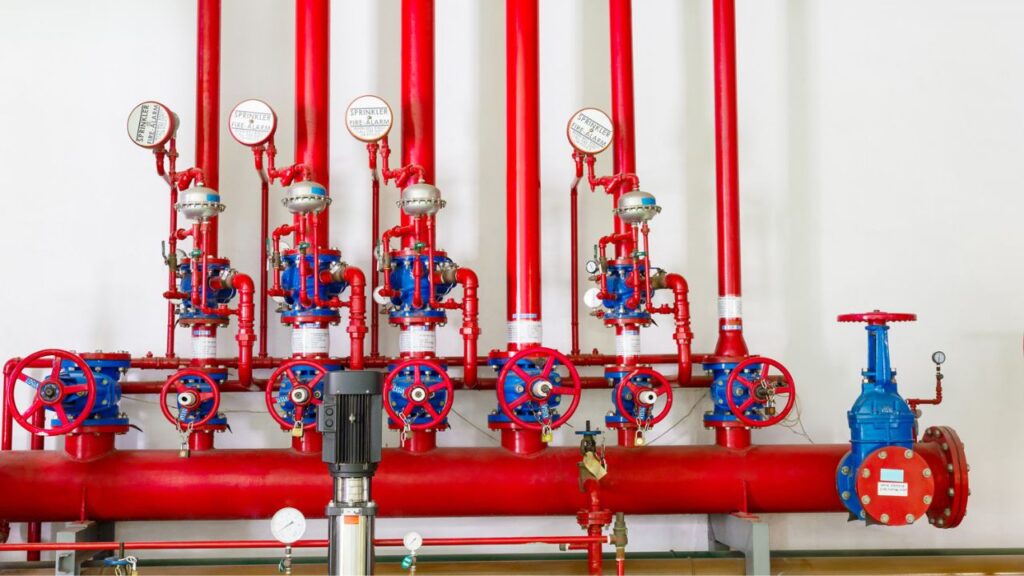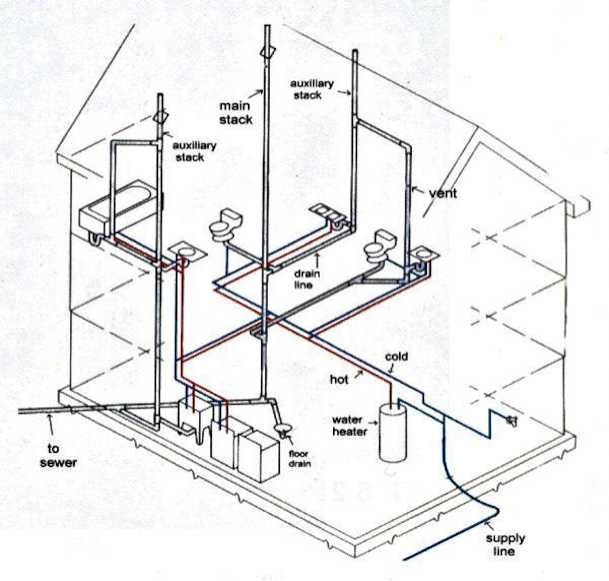We've come across the article involving The Inner Workings of Your Home's Plumbing down the page on the web and believe it made good sense to quickly share it with you on my blog.

Recognizing just how your home's plumbing system works is important for each property owner. From delivering tidy water for alcohol consumption, food preparation, and bathing to securely getting rid of wastewater, a well-maintained pipes system is important for your family members's health and wellness and comfort. In this comprehensive guide, we'll discover the complex network that composes your home's plumbing and deal suggestions on upkeep, upgrades, and taking care of usual concerns.
Introduction
Your home's pipes system is more than just a network of pipelines; it's a complex system that ensures you have access to tidy water and efficient wastewater elimination. Recognizing its elements and how they collaborate can aid you stop costly repairs and ensure everything runs smoothly.
Basic Parts of a Pipes System
Pipelines and Tubes
At the heart of your plumbing system are the pipelines and tubes that carry water throughout your home. These can be made from various materials such as copper, PVC, or PEX, each with its advantages in regards to sturdiness and cost-effectiveness.
Fixtures: Sinks, Toilets, Showers, and so on.
Components like sinks, bathrooms, showers, and bathtubs are where water is utilized in your home. Understanding exactly how these fixtures attach to the pipes system helps in identifying issues and preparing upgrades.
Valves and Shut-off Points
Valves manage the flow of water in your pipes system. Shut-off shutoffs are essential during emergency situations or when you require to make repair work, permitting you to separate parts of the system without interfering with water flow to the entire home.
Water Supply System
Main Water Line
The major water line connects your home to the local water system or an exclusive well. It's where water enters your home and is distributed to numerous components.
Water Meter and Pressure Regulator
The water meter steps your water usage, while a pressure regulator makes sure that water flows at a safe pressure throughout your home's plumbing system, preventing damage to pipelines and fixtures.
Cold Water vs. Hot Water Lines
Comprehending the difference between cold water lines, which supply water directly from the main, and hot water lines, which carry heated water from the water heater, helps in troubleshooting and planning for upgrades.
Drainage System
Drain Pipes Water Lines and Traps
Drain pipelines lug wastewater away from sinks, showers, and toilets to the drain or septic system. Traps protect against sewage system gases from entering your home and likewise catch debris that could trigger obstructions.
Air flow Pipelines
Ventilation pipes enable air into the water drainage system, preventing suction that could reduce water drainage and cause traps to empty. Appropriate ventilation is necessary for preserving the stability of your plumbing system.
Significance of Correct Drainage
Ensuring correct water drainage stops back-ups and water damages. On a regular basis cleansing drains and keeping traps can avoid expensive repair work and prolong the life of your pipes system.
Water Heating Unit
Sorts Of Hot Water Heater
Water heaters can be tankless or standard tank-style. Tankless heating systems warmth water on demand, while storage tanks keep heated water for instant use.
Exactly How Water Heaters Connect to the Pipes System
Comprehending exactly how water heaters attach to both the cold water supply and hot water distribution lines aids in detecting problems like insufficient hot water or leakages.
Maintenance Tips for Water Heaters
Regularly purging your hot water heater to get rid of sediment, inspecting the temperature setups, and inspecting for leaks can expand its life-span and enhance power performance.
Typical Plumbing Problems
Leaks and Their Reasons
Leakages can take place as a result of aging pipelines, loose installations, or high water stress. Addressing leaks quickly protects against water damages and mold and mildew development.
Clogs and Blockages
Obstructions in drains and toilets are commonly caused by flushing non-flushable things or a buildup of oil and hair. Making use of drainpipe screens and being mindful of what decreases your drains pipes can protect against clogs.
Indicators of Pipes Issues to Watch For
Low water pressure, slow-moving drains, foul odors, or abnormally high water bills are indications of possible plumbing troubles that need to be dealt with promptly.
Pipes Upkeep Tips
Normal Assessments and Checks
Schedule annual plumbing examinations to catch problems early. Search for signs of leaks, deterioration, or mineral build-up in faucets and showerheads.
Do It Yourself Maintenance Tasks
Simple tasks like cleaning tap aerators, looking for toilet leaks utilizing color tablets, or protecting subjected pipes in cold climates can avoid major plumbing problems.
When to Call a Professional Plumbing Professional
Know when a plumbing problem requires expert proficiency. Trying intricate fixings without proper knowledge can cause even more damages and higher repair work prices.
Updating Your Plumbing System
Reasons for Updating
Upgrading to water-efficient fixtures or changing old pipes can boost water quality, reduce water costs, and raise the worth of your home.
Modern Plumbing Technologies and Their Benefits
Discover modern technologies like wise leakage detectors, water-saving toilets, and energy-efficient water heaters that can conserve money and reduce environmental impact.
Expense Factors To Consider and ROI
Determine the ahead of time expenses versus long-lasting savings when considering pipes upgrades. Several upgrades spend for themselves with minimized utility costs and less fixings.
Ecological Impact and Conservation
Water-Saving Fixtures and Devices
Mounting low-flow taps, showerheads, and commodes can significantly lower water use without compromising performance.
Tips for Reducing Water Use
Easy behaviors like fixing leaks immediately, taking shorter showers, and running full tons of washing and recipes can save water and reduced your utility costs.
Eco-Friendly Plumbing Options
Consider lasting plumbing materials like bamboo for flooring, which is durable and green, or recycled glass for countertops.
Emergency situation Preparedness
Steps to Take Throughout a Pipes Emergency situation
Know where your shut-off shutoffs lie and exactly how to shut off the supply of water in case of a ruptured pipe or significant leakage.
Significance of Having Emergency Situation Contacts Helpful
Maintain get in touch with details for local plumbing professionals or emergency solutions conveniently available for fast response throughout a plumbing dilemma.
Do It Yourself Emergency Situation Fixes (When Appropriate).
Momentary solutions like using air duct tape to spot a leaking pipe or putting a bucket under a trickling faucet can lessen damages till a professional plumbing professional arrives.
Final thought.
Comprehending the makeup of your home's pipes system empowers you to maintain it efficiently, conserving money and time on repair services. By adhering to routine upkeep routines and remaining informed regarding modern pipes technologies, you can guarantee your pipes system operates successfully for years to find.
The Anatomy of Your Home s Plumbing System
Understanding the anatomy of your home s plumbing system is essential for any homeowner. It not only helps in identifying potential issues but also facilitates effective communication with professionals when repairs or upgrades are needed. Your home s plumbing system is more than just pipes and faucets; it s a complex network that ensures the efficient and hygienic flow of water in and out of your house. In this blog, we ll dissect the crucial components of your home s plumbing system. For those in Antelope Valley, Brock Plumbing is your trusted partner for all your plumbing needs, ensuring your system functions smoothly and efficiently.
Water Supply System
Main Water Line: This is where your home s plumbing system begins. The main water line connects your home to the public water supply or a private well. Pipes and Shut-off Valves: Pipes distribute water throughout your home. Shut-off valves are crucial for controlling the flow of water and making repairs without shutting off the entire system. Drainage System
Drain Pipes: These pipes carry waste and water away from sinks, toilets, and showers. Vents: Vents allow sewer gases to escape and help maintain proper pressure in the drainage pipes, ensuring efficient flow of wastewater. Traps: Every fixture has a trap, a U-shaped pipe that holds water and prevents sewer gases from entering your home. The most common is the P-trap under sinks. Fixtures and Appliances
Fixtures and appliances are the most interacted with parts of your plumbing system. They include sinks, toilets, showers, dishwashers, and washing machines. Each fixture and appliance has its own supply and drainage connection, ensuring they receive clean water and can dispose of wastewater effectively.
Water Heating System
Your water heater is a crucial component, providing hot water to various fixtures and appliances in your home. It can be tank-based or tankless, with each type having its own set of advantages and maintenance requirements. Regular maintenance is essential to ensure efficient operation and extend the lifespan of the unit.
Sump Pump
In areas prone to flooding or with high water tables, a sump pump is an essential part of the plumbing system. It s installed in the lowest part of your basement or crawlspace and pumps out water that accumulates, preventing flooding and protecting your home from water damage.
Septic System
Homes that are not connected to a municipal sewer system have a septic system and an underground wastewater treatment structure. Understanding how to maintain your septic system is crucial to prevent backups, odors, and early system failure.
Conclusion
Your home s plumbing system is a complex and essential network, ensuring the efficient and hygienic flow of water in and out of your property. Understanding its key components helps in maintaining it properly and identifying issues before they escalate into major problems. For residents in Antelope Valley, Brock Plumbing is dedicated to providing top-notch services, ensuring that every part of your plumbing system is in perfect working order. Trust our team of professionals to handle all your plumbing needs, ensuring your home remains comfortable, safe, and well-maintained.
https://brockplumbinganddrains.com/blog/the-anatomy-of-your-homes-plumbing-system/

I discovered that piece about Anatomy of a House: Understanding the Components while doing a search on the internet. Sharing is nice. Helping people is fun. We recognize the value of your readership.
Click Here To Find Out More
 Neve Campbell Then & Now!
Neve Campbell Then & Now! Taran Noah Smith Then & Now!
Taran Noah Smith Then & Now! Molly Ringwald Then & Now!
Molly Ringwald Then & Now! Gia Lopez Then & Now!
Gia Lopez Then & Now! Nicholle Tom Then & Now!
Nicholle Tom Then & Now!